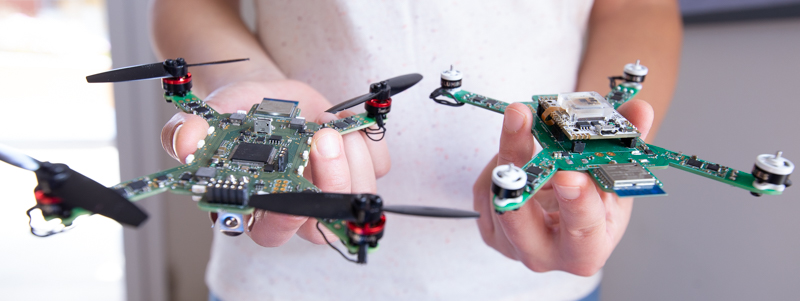Drones have come a long way in the past decade, and a lot of the pioneering work that made them mainstream was done by individual hackers and small teams. This often involves cobbling together components into flying crow’s nests of wiring. To streamline things a bit for hackers, the team at Luminous Bees are working on Ardubee, a small 3″ drone designed from the ground up for hacking.
The Ardubee is built around a single PCB that also acts as the frame of the drone. Onboard is an STM32F427 microcontroller, IMU, barometer and compass, ESCs, ESP8266 for telemetry, and a downward-facing range finder. It’s ready to connect to an SBUS RC receiver and a range of pluggable modules are in development to expand the drone’s capabilities. It’s designed to run the open-source Ardupilot software, which we’ve seen in so many DIY autonomous vehicles. Power is provided by a single 18650, which will probably limit higher speed maneuverability a bit but should be fine for the slower precision flight that such a drone is likely to be used for.
The team already has a swarm of larger 5″ drones that they developed for light shows. In the process they developed their own Ultrawide-band indoor positioning system, which will also be available for the Ardubee. They hope to launch a Kickstarter campaign soon and are asking for input from the community, so they can know what features need to be prioritized. We look forward to seeing where this project goes!
Autonomous vehicles are a popular topic around here for air, land, and water, and we have no doubt there will be many more.
Thanks for the tip [Andreas]!
















I know they’re not the only ones that have used a monolithic PCB as the airframe, but AFAIK those tend to be the cheapies. Personally I’d prefer the electronics to either be packaged together in central component that is relatively crash resistant, or something more modular, allowing ruined parts to be conveniently replaced. In this design, a snapped boom scraps the whole thing, save for maybe the motors. Unless you really like working with SMD components…
They’re probably pretty robust as long as you’re better at flying than crashing.
Seperate frame elements with flexible wires, allows for repair easily after a crash, versus trying to solder and epoxy a broken PCB and traces back together.
Indeed, there should be built-in fracture points where 3D printed adapters could be added to adapt for when the inevitable happens. At said built-in fracture points should be pads for attaching wiring instead of trying to scrap and solder to thin torn traces.
Much more interresting than the PCB design ist their indoor positioning system.
From the photo in the linked forum post, their indoor navigation seems to be based on the Decawave (apparently now named “Qorvo”) module https://www.decawave.com/product/dwm1000-module/
I understand where the comments about durability concerns are coming from but feel like they’re misplaced. This is a tiny (3″), lightweight (102g with battery!) , and open-hardware based design. Making it modular would improve durability at the expense of those aspects (and add to the cost of materials / manufacturing). Obviously these things can crash and break just like anything else, but ultra-lightweight drones are a lot more durable than you might expect (F=m*a). I’d expect most crashes to be survivable; even if it falls straight out of the sky onto a rock, it’s unlikely to hit hard enough to damage the PCB itself, and the motors and battery stick out such that the other components on the board are somewhat protected from direct impact. Plus, for many of their intended use cases (drone swarms, education) where you’re buying a lot of drones up-front, the cost savings of making a non-modular unit could be directed toward a lot of spares. The folks at Luminous Bees aren’t amateurs – they’ve been around for many years designing and flying drone swarms for light shows. I’m not suggesting they made the right tradeoffs for everyone, but I’m sure they took all these considerations into account.
For larger, fancier drones (where “larger” includes even small drones like the Mavic mini), or drones intended for racing/stunts, a more modular design is unquestionably superior for the pilot.
Some sort of T-beam under the ESC laden motor arms to make them more rigid would make me feel better. They could even be 3D printed.
Or aluminium beams soldered to the pcb? Pads could feature a lot of small vias (like esc’s have) to boost rigidity
The soldering will break first, not the pcb, and you got a electronics full of unreliable solderings.
Or imagine some of the SMT capacitors or resistors just break away, try to find the problem.
These would be perfect for light shows, though, where ease of manufacturing and cost are a major factor and, presumably, you’ve overcome the crashing problem :-)
Crazyflies have been pcb frames since the beginning. Lots of researchers use it since 2012. Mind that they’re tello/whoop size. Nothing new here.
Very nice but like everyone knows,i is very likely to get broken on a crash.
alert(1)lol